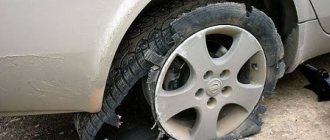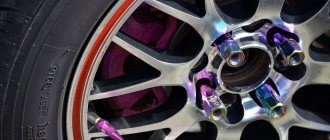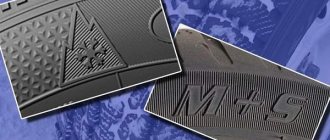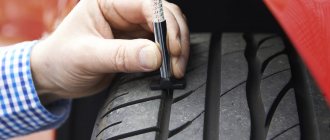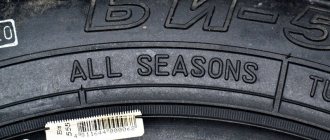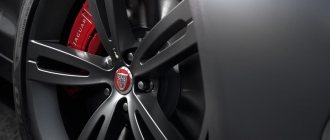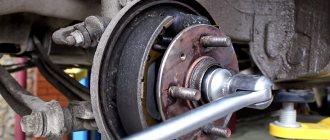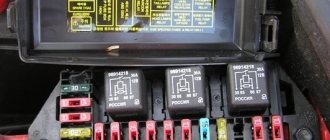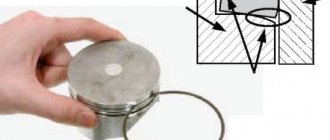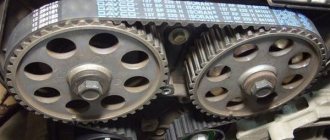In the previous part of this article, we began to look at the marking of passenger car tires and its interpretation. Here I want to continue talking about the designations used when marking rubber tires.
- Tire wear indicator
- Colored tire markings
- Max. load and pressure
- direction of tire rotation. asymmetric tires
- Stickers on new tires
Tire wear indicator
It is no secret that during operation the tire tread wears out and wears off. The degree of wear of a tire varies, and in order to know in time about the need to buy new tires, wear indicators are provided on the tire.
There are several types of wheel tread wear indication.
Tire tread wear indicator
- Numerical - in the form of numbers on the surface, printed at different depths
- Ribs on the tread - when the tread wears down to the ribs, this is the minimum allowable remaining tread depth.
- Values in % - mainly used on winter tires. Means the same as numbers
On the side of the tire, opposite the wear indicators, there is a triangle or the letters TWI (Tread Wear Indication) . They indicate the location of the tread wear indicators.
Attention! There is a maximum permissible tire wear limit! For European countries and Russia, this is wear at which the minimum wheel tread depth is 1.6 mm. It is believed that with this tread depth the tire is still able to resist hydroplaning.
Important! If the tread on one wheel wears off more than on the others, or uneven tire wear is noticeable, this indicates that the alignment needs to be adjusted .
Why and how tires on a car wear out
Wear occurs for various reasons.
- Speed. The faster you drive, the faster the tire life ends. One of the main factors is driving style. If you regularly brake hard or accelerate hard, the material will wear out much faster than when driving calmly.
- Load on drive and steered wheels. The nature of wear is directly affected by the type of machine drive and, accordingly, traction force. Steered wheels wear out faster on the side parts, since they bear the greatest part of the impact when cornering. In drive wheels, such as rear wheels, problems most often arise with the central part of the tires, since it comes into contact with the asphalt most closely. In a front-wheel drive vehicle, wear will be uniform across the entire tire.
- Emergency braking with wheel lock. Such actions can lead to serious consequences for the tires - for example, the appearance of a rather large wear mark on the overloaded part of the tire. In this case, the wheel loses its ability to rotate normally, so the tire will need to be changed urgently.
This is interesting: Services for checking the legal purity of a used car
Tire wear due to improper use of the car
- Leaving the vehicle stationary for a long time. If the car sits in one place for a long time, flat wear areas may appear on the tires. Driving with such tires leads to “beating” of the wheels. If you plan to park your car for a long time, be sure to increase the tire pressure.
- Braking after driving in a sporty style. When driving hard, tires heat up and when you stop, they change shape at the point of contact with the road. True, when heated, their original shape returns.
- Insufficient or excessive pressure. If the pressure is too low, the tire will wear out faster at the edges. Too high - on the contrary, in the middle.
- Aging of material. Rubber cannot exist forever - over time, its tightness is broken. Moisture gets inside, causing tears and other defects. It is not recommended to use tires that are already 10 years old.
The faster you drive, the faster your tires wear out.
Types of wear on car tires
- Sawtooth. Most often it occurs on tires that are located on the driven axle. The problem often appears when driving too slowly, especially with low tire pressure. With sawtooth wear, the car makes more noise when driving.
- One-sided, uneven. Often caused by suspension problems. If you find that your tires are wearing more on one side, be sure to check your wheel alignment. Poor condition of the outside of the tire means excessively high positive camber or toe. If the internal part is worn out, negative toe and camber occur. Zero camber and toe also accelerate wear, which should be taken into account when calculating wear rates.
- Repeated wear areas around the entire circumference of the tire. This problem is typical for cars with poor suspension conditions - for example, if the levers and springs are faulty. Once the problem has been resolved, replace the tire as it will no longer be able to do its job.
- Truck tires wear out due to severe skidding, dragging or dragging, as well as due to the characteristics of the tire material. Thus, during sharp acceleration, braking or sharp turns, ridge longitudinal wear appears and tread blocks crack. It is often impossible to avoid driving in difficult conditions, so truck owners must periodically inspect the condition of their tires and rotate them from time to time.
Colored tire markings
You may have noticed that some new tires have colored markings, 2 colored dots, red and yellow. This was done for better wheel balancing during tire fitting.
Colored tire markings
The yellow dot indicates the lightest spot on the tire. When mounting tires, this mark is aligned with the hole in the rim for the nipple.
The red dot is the hardest part. Or a part with greater heterogeneity of the material.
Colored stripes on the tire tread
Colored stripes on the tread are mainly used to facilitate sorting in warehouses and for logistics purposes. They do not carry any other information.
Tire replacement frequency
In order to perform car maintenance on time, it is not necessary to determine the degree of tire wear. You just need to know the approximate replacement interval. You need to change tires based on the kilometers driven. As a rule, the standard figure for tires alone is 40-50 thousand km. Some motorists manage to reach this number in a couple of years, others need 4-5. Everything is very individual. In addition to replacing them every few years, tires also need to be changed based on the season. There are models on the market that are suitable for both winter and summer, but in practice they are not as effective as regular summer and winter tires.
Maximum load and pressure
It is extremely important to adhere to the recommended load and tire pressure values. Therefore, each manufacturer indicates this data on the side of the tire.
Marking of maximum load and tire pressure
These data indicate the permissible load on 1 wheel (!) . This data is also indicated in the load index.
The following markings are also found:
- Reinforced - means reinforced tires, that is, the load index is increased.
- XL or Extra load - means an increased load index by 4 units.
Tire rotation direction. Asymmetrical tires
Not all tires are the same. There are tires for which the direction of rotation of the wheel matters, and which side of the wheel faces outward and which side faces inward. Such tires are called directional , or with an asymmetric tread pattern .
The correct direction of wheel rotation is indicated by an arrow and the word Rotation.
There are also inscriptions like outside . Which means you need to install the tire with this side facing out.
How to determine the side of a tire
Such measures are due to the asymmetrical or directional tread pattern, which is designed for effective adhesion to the surface. If the pattern is directional, it means that it only provides the desired tire performance when rotated in the desired direction.
Symmetrical and asymmetrical tread types
Requirements in traffic rules
In 2021, the traffic rules introduced new requirements for wheels and tires. Traffic police officers may issue you a fine or seize your vehicle if you do not comply with the tread depth requirements.
- If you are a motorcycle owner, then the tread height should be at least 0.8 mm.
- For cars, the minimum number is 1.8 mm.
- For trucks, the tread must be at least 1 mm.
Stickers on new tires
You've probably all noticed the colored stickers on new tires, but not all of you know what they mean. let's take a closer look.
Stickers on new tires
RRC (Rolling Resistance Coeficient) - Rolling resistance coefficient.
RRC - Rolling Resistance Coefficient
Indicated by a letter index from A to G. The best indicator is considered to be index A. The rest increase fuel consumption on the reference car in accordance with the table. a passenger car that consumes 6.6 liters. gasoline per 100 km.
Noise level outside the car
Noise level outside the car
It is measured in decibels (dB) and is indicated by a picture of a speaker and a wheel. Completely black waves mean a noise level of 75 dB or higher, which will be prohibited in EU countries from 2021. The remaining data is shown in the figure.
Grip on wet asphalt
Indicated by letters from A to G. A - the best performance, that is, the shortest braking distance on wet asphalt.
Grip on wet asphalt
WGI - wet grip index , measured in % relative to the reference width.
The table shows the differences in braking efficiency for different grip classes on wet asphalt.
Results
The degree of tread wear is one of the most important values that directly affects your safety. In no case should you skimp on it, because the health of you and your passengers depends on the quality of the tires. If you don’t have enough time to go for diagnostics and technical inspection, then the methods described in this article can help you. They do not take much time, but they allow you to quickly determine the degree of tire wear. Tires, like any other product, have their own expiration date, and it is best to change them once every 6 years or more often. After all, you need to think about safety first of all.
